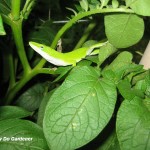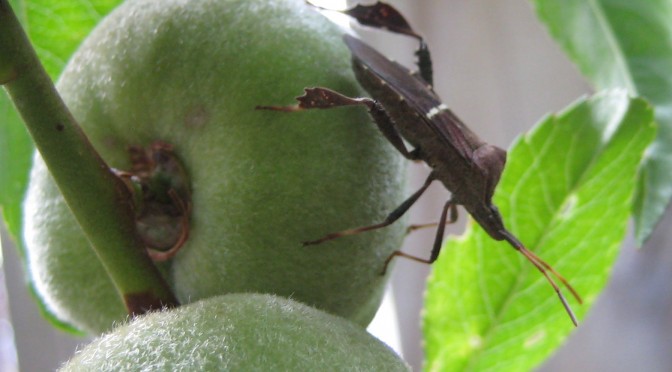Imagine that it’s a crisp, clear, sunny spring morning. You just woke up, grabbed a fresh hot cup of coffee, and are walking out to the driveway to admire that new car you just bought. And why not admire it? You worked hard for it. You spent all winter researching different models and planning your purchase. Plus, you just spent a few hours yesterday washing and waxing it.
Suddenly you stop dead in your tracks. “What the…!” You notice bits of broken glass on the ground near where the side window used to be. And there, sitting in the driver seat with a bunch of loose wires in his hand and a smirk on his face is that teenager from down the street. You’ve seen him hanging around the street corner. You’ve heard from neighbors of the trouble he’s caused them. But you never thought you’d catch him red handed trying to take something of yours.
That’s pretty much how you feel when you go out to your garden and see a bunch of pill bugs eating your strawberries, a stinkbug sucking on one of your peaches, or a grasshopper gnawing on your lettuce. To paraphrase that infamous Sith Lord, “Take your pesticide, Strike down the cabbage looper with all of your hatred, and your journey to the dark side will be complete.”
Integrated Pest Management
Fortunately, by utilizing a technique called Integrated Pest Management, we can control pests in our garden without making our backyard a nuclear waste dump. According to the Department of Horticultural Sciences, and the Department of Entomology at Texas A&M University, Integrated Pest Management (IPM) for the home vegetable garden consists of four key strategies:
1) Plant genetic resistance to pests and disease
2) Biological control (the use of one organism to control another)
3) Environmental and cultural (favorable for the plant, unfavorable for the pest)
4) Chemical
Plan Ahead
IPM starts before you even plant your garden. Choose vegetable varieties that are resistant to pests and diseases or that will continue to grow and produce vegetables in spite of pest damage. Your state Cooperative Extension system is an excellent source of information on vegetable varieties that do best in your area. Check my post from March 2011 for a listing of, and links to, the Cooperative Extension agencies in each state.
Healthy Plants
A healthy plant can better survive pest damage and ward off disease. Place your garden in an area that receives at least 6-8 hours of full sunlight each day. Ensure that the soil in your garden is high in organic matter and drains well. Consider using raised beds. Water your plants deeply and regularly, but don’t over water. To help prevent plant diseases, always water early in the morning so the foliage will have a chance to dry during the day. Consider drip irrigation. Many pests live, and eat, on the underside of foliage. Sometimes just spraying the affected area with a garden hose will at least temporarily wash them off.
Keep the Bugs Out
Keep your garden clean and weed free. Always remove any dead or diseased foliage from your plants, and remove weeds and plant debris from your garden as they can harbor pests. Consider covering your plants with floating row covers. A floating row cover is a lightweight fabric that can be purchased from your local garden supply store. The fabric allows rain, and 85 to 90% of sunlight to penetrate. It can protect your plants from wind damage and offers some moderate frost protection as well. Be sure to uncover your plants when they are flowering so that bees and other pollinators have access.
According to the AgriLIFE EXTENSION, Texas A&M System, an estimated 70% of all plant problems are caused by cultural practices rather than insects and diseases.

Biological Control
Biological control is the use of one organism to help control another. Most pests have natural predators or parasites that can help to keep a pest population in check. Introducing companion plants into your garden can provide a desirable environment for these beneficial predators and parasites. Some companion plants may exude natural chemicals that repel pests. Other companion plants can even be used as a trap crop, a plant that the pest is more attracted to than your vegetables.
Identify the Problem
There are more than 30,000 species of insects found in Texas alone; fewer than 100 of these cause problems in vegetable gardens. These insects come in a vast assortment of sizes, shapes, and colors, and can fly, walk, crawl, or dig their way into your garden. For any given insect species, its appearance and often its mode of transportation will change dramatically as it progresses through its life cycle.
The key to proper identification, and successful control, of pests is early detection. Pests can migrate to, or reproduce in your garden very quickly and in large numbers. If possible, make it part of your daily routine to spend time in your garden each morning. It’s a good time to see how your plants are growing, water your plants, inspect your plants for any signs of pests, and if you’re lucky harvest a few fresh vegetables.
Vegetable IPM website
Here is a link to the Integrated Pest Management for the Home Vegetable Garden website, http://vegetableipm.tamu.edu/. This site will help you identify an insect, both pests and beneficial insects, by its name, a picture, the type of damage it’s doing, or by the vegetable it’s damaging. It also offers different methods of controlling the pests.
Chemical Control
The mention of chemicals to control pests often conjures up images of someone in a HAZMAT suit pumping barrels of highly toxic substances all over your vegetables. But many pesticides are derived from natural substances and are approved for organic gardening usage. The toxicity level of a pesticide is rated by its Lethal Dosage (LD50) Value. According to the United States Environmental Protection Agency, An LD50 is a standard measurement of acute toxicity that is stated in milligrams (mg) of pesticide per kilogram (kg) of body weight. An LD50 represents the individual dose required to kill 50 percent of a test population. Because LD50 values are standard measurements, it is possible to compare relative toxicities among pesticides.
The lower the LD50 dose, the more toxic the pesticide. A pesticide with an LD50 value of 10 mg/kg is 10 times more toxic than a pesticide with an LD50 of 100 mg/kg. The table below shows the LD50 levels of several chemicals.
Pesticide Acute Toxicity by LD50
Source: Montgomery County Texas Extension
| Chemical | LD50 Rating | |
|---|---|---|
| Nicotine | 55 | MOST TOXIC |
| Dursban | 163 | |
| Sevin | 246-500 | |
| Diazinon | 300-850 | |
| Orthene | 866-945 | |
| Ryania | 1,200 | |
| Rotenone | 1,500 | |
| Aspirin | 1,200-1,750 | |
| Malathion | 2,800 | |
| Table Salt | 3,500 | |
| Spinosad | 3,700-5,000 | |
| Sabadilla | 5,000 | |
| Glyphosate | 5,600 | |
| Benomyl | > 10,000 | |
| Neem | > 10,000 | |
| Insecticidal Soap | > 10,000 | |
| B.T. | > 10,000 | |
| Pyrethrum | > 18,000 | LEAST TOXIC |
Summary
Do your best to prevent pests before they can do a lot of damage. Attract beneficials to your garden. Have patience. All gardens have at least a few pests. Monitor outbreak areas before you spray. Know your pest. By properly identifying the pest and its current stage of development, the appropriate pesticide can be chosen. Choose a pesticide that kills only the pest and not beneficials.
Trying to use “the force” or a “light saber” to keep pests out of your garden probably won’t work. But a little hard work and a well-planed Integrated Pest Management program will go a long towards ensuring a bountiful garden harvest.

